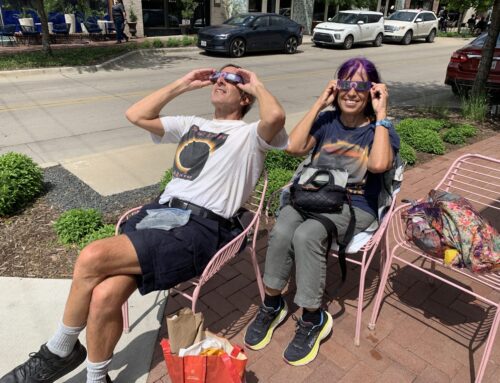Bookbinding is about as common nowadays as typewriter repair.
There are a few who still do it, but none working in such stylish digs as Oak Cliff’s own, The Book Doctor.
The Book Doctor’s original owner, Julie Schleier, started it 20 years ago in the kitchen of her Oak Cliff home. She later moved it to a space in Uptown and then the Bishop Arts District. Schleier’s employee, Candice McKay, bought the business six years ago, and last year, she moved it to a light-filled corner space in the 1920s retail building on West Davis at Edgefield.
“I have always really liked this building, as a lot of people have, and I live two blocks away,” McKay says.
The Book Doctor’s clientele is diverse. It crafts binding for new works: family histories, dissertations and corporate annual reports, for example.
But book restoration makes up the bulk of the work. Old family Bibles are among the most common restoration jobs. And there are many other projects — children’s storybooks, recipe books and yearbooks, for example — the values of which typically are far more sentimental than monetary.
It also has clients who are book collectors, particularly those who are just beginning to pursue a collection. If they bring McKay a book that has some wear, she can restore it enough at least to maintain if not increase its value.
“People in this area collect really interesting things in thoughtful ways,” she says. “It’s nice to get a peek into that. I’m not a collector; I don’t have that in my personality. So it’s nice to see other people’s collections.”
The Book Doctor recently produced “presentation boxes” for rare Audubon prints, for example.
McKay learned bookbinding for fun one winter in New Haven, Conn., where she worked for several years at Yale University Press.
She began working for The Book Doctor when she and her husband moved to Dallas 10 years ago. The craft of bookbinding is inspiring, but it can be hard to estimate how long a restoration will take.
Disjoining a book can be like creating a puzzle; putting it back together takes craft and artistry. The Book Doctor has two professional artists on staff who can paint a book spine to match the original cover design, among other magical strokes. They use letterpress to emboss words onto new leather covers and spines. They use high-quality supplies, including Scotland-based J. Hewitt & Sons’ calf leather, Harmatan goatskin from England and acid-free Japanese paper.
“One reason there aren’t more book binders or restoration studios out in the open is the overhead is so high between the cost of running a business and the materials,” McKay says.
Schleier had an accounting background, so she managed the business very well. And since there are so few bookbinders, The Book Doctor stays very busy.
Since the workshop has been in its new, much more visible space, McKay estimates they get about 20 walk-ins a month.
“I think someone recommended us at a party,” she says. “We’ve been getting a ton of work from the neighborhood, and everyone’s been really nice.”
The Book Doctor’s tips for maintaining old books:
• Keep them dusted and well-supported on a shelf.
• Big books should be laid flat and never up on their spines.
• Keep them out of the sun and away from heating vents.
• Leather books should be treated with a leather conditioner that doesn’t contain neatsfoot oil.
• Never use petroleum-based products on leather books. As McKay puts it: “If you have to go to the bathroom or the garage to get it, it probably doesn’t belong in your book.”





